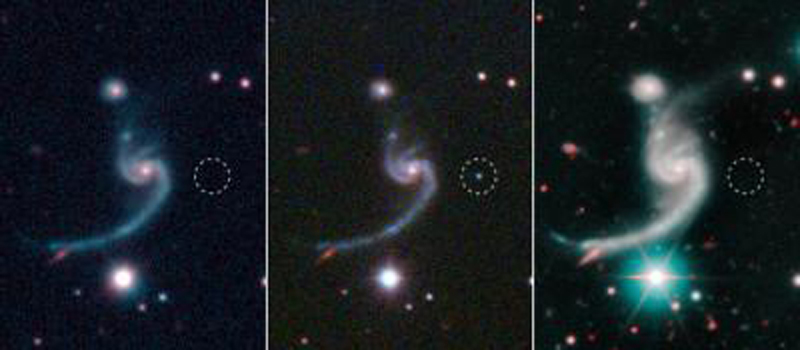Dying Massive Star Goes out With a Whisper
Posted on Categories Discover Magazine

Astronomers were surprised at how wimpy the explosion was from this dying star. (Credit: NASA/JPL-Caltech/R. Hurt)
A Strange, Dying Star
Astronomers watched the strange death of a massive star that had a surprisingly “wimpy” and fast explosion in a galaxy 920 million light-years away. According to the researchers, this unusual explosion suggests that the dying star had a secret companion that was stripping away the star’s mass, leading to the surprisingly fast supernova. The team, led by CalTech graduate student Kishalay De, believes that this explosion birthed a binary neutron star binary system. They suspect the pair consists of the neutron star left behind by the supernova, called supernova iPTF14gqr, and the nearby, dense companion object that was stripped away the star’s mass before it exploded. If this is true, it would be the first time researchers have actually observed such a system.
A supernova occurs when a massive star runs out of fuel and its core collapses, causing the star to explode and appear temporarily, extraordinarily bright. The explosion blasts away mass in the star’s outer layers, leaving behind a dense neutron star.
“A typical supernova is slow evolving,” De said. But this supernova evolved extremely fast by comparison. Even stranger, while the the star that exploded must have been at least eight times the sun’s mass, just one-fifth the mass of the sun was ejected in the explosion, De said.
“A typical massive star explosion ejects about five times the mass of the sun,” he added.
A Wimpy Supernova
So, this massive star explodes, but only a relatively small amount of mass is ejected and it goes by much quicker than anticipated. “It’s a whisper … a really wimpy explosion from a massive star,” De said.
“We call this an ultra-stripped envelope supernova and it has long been predicted that they exist,” but, De added, “This is the first time we have convincingly seen core collapse of a massive star that is so devoid of matter.”
This “missing matter” was stolen by the gravity of a dense object next to the star, according to the researchers. This dense object could have been a white dwarf, a neutron star, even a black hole.
So, when the star exploded and left a dense neutron star behind, that dense object was actually born into orbit with the nearby dense object that had stolen the original star’s mass. And thus, the binary stellar system was created.
This work was published Oct. 11, 2018 in the journal Science.